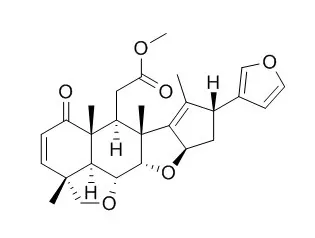| In vitro: |
| Mol Cancer Ther. 2014 May;13(5):1067-77. | | Preclinical evaluation of the supercritical extract of azadirachta indica (neem) leaves in vitro and in vivo on inhibition of prostate cancer tumor growth.[Pubmed: 24674886] | Azadirachta indica, commonly known as neem, has gained worldwide prominence because of its medical properties, namely antitumor, antiviral, anti-inflammatory, antihyperglycemic, antifungal, and antibacterial activities. Despite these promising results, gaps remain in our understanding of the molecular mechanism of action of neem compounds and their potential for use in clinical trials.
METHODS AND RESULTS:
We investigated supercritical extract of neem leaves (SENL) for the following: molecular targets in vitro, in vivo efficacy to inhibit tumor growth, and bioactive compounds that exert antitumor activity. Treatment of LNCaP-luc2 prostate cancer cells with SENL suppressed dihydrotestosterone-induced androgen receptor and prostate-specific antigen levels. SENL inhibited integrin β1, calreticulin, and focal adhesion kinase activation in LNCaP-luc2 and PC3 prostate cancer cells. Oral administration of SENL significantly reduced LNCaP-luc2 xenograft tumor growth in mice with the formation of hyalinized fibrous tumor tissue, reduction in the prostate-specific antigen, and increase in AKR1C2 levels. To identify the active anticancer compounds, we fractionated SENL by high-pressure liquid chromatography and evaluated 16 peaks for cytotoxic activity. Four of the 16 peaks exhibited significant cytotoxic activity against prostate cancer cells. Mass spectrometry of the isolated peaks suggested the compounds with cytotoxic activity were nimbandiol, nimbolide, 2',3'-dihydronimbolide, and 28-Deoxonimbolide. Analysis of tumor tissue and plasma samples from mice treated with SENL indicated 28-Deoxonimbolide and nimbolide as the bioactive compounds.
CONCLUSIONS:
Overall, our data revealed the bioactive compounds in SENL and suggested that the anticancer activity could be mediated through alteration in androgen receptor and calreticulin levels in prostate cancer. | | J Nat Prod. 2011 Apr 25;74(4):866-70. | | Cytotoxic and apoptosis-inducing activities of limonoids from the seeds of Azadirachta indica (neem).[Pubmed: 21381696 ] |
METHODS AND RESULTS:
Thirty-five limonoids, including 15 of the azadiradione type (1-15), five of the gedunin type (16-20), four of the azadirachtin type (21-24), nine of the nimbin type (25-33), and two degraded limonoids (34, 35), isolated from Azadirachta indica seed extracts, were evaluated for their cytotoxic activities against five human cancer cell lines. Seven compounds (3, 6, 7, 16, 18, 28, and 29) exhibited cytotoxic activity against one or more cell lines. Among these compounds, 7-deacetyl-7-benzoylepoxyazadiradione (7), 7-deacetyl-7-benzoylgeduin (18), and 28-Deoxonimbolide (28) exhibited potent cytotoxic activity against HL60 leukemia cells with IC(50) values in the range 2.7-3.1 μM. Compounds 7, 18, and 28 induced early apoptosis in HL60 cells, observed by flow cytometry. Western blot analysis showed that compounds 7, 18, and 28 activated caspases-3, -8, and -9 in HL60 cells.
CONCLUSIONS:
This suggested that compounds 7, 18, and 28 induced apoptotic cell death in HL60 cells via both the mitochondrial- and the death receptor-mediated pathways. Futhermore, compound 7 was shown to possess high selective cytotoxicity for leukemia cells since it exhibited only weak cytotoxicity against a normal lymphocyte cell line (RPMI 1788). |
|






 Cell. 2018 Jan 11;172(1-2):249-261.e12. doi: 10.1016/j.cell.2017.12.019.IF=36.216(2019)
Cell. 2018 Jan 11;172(1-2):249-261.e12. doi: 10.1016/j.cell.2017.12.019.IF=36.216(2019) Cell Metab. 2020 Mar 3;31(3):534-548.e5. doi: 10.1016/j.cmet.2020.01.002.IF=22.415(2019)
Cell Metab. 2020 Mar 3;31(3):534-548.e5. doi: 10.1016/j.cmet.2020.01.002.IF=22.415(2019) Mol Cell. 2017 Nov 16;68(4):673-685.e6. doi: 10.1016/j.molcel.2017.10.022.IF=14.548(2019)
Mol Cell. 2017 Nov 16;68(4):673-685.e6. doi: 10.1016/j.molcel.2017.10.022.IF=14.548(2019)